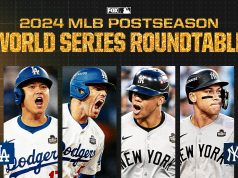[ad_1]
¡Es hora de los playoffs de la MLB! Después de un sprint salvaje hasta la línea de meta, que es necesario cada día de la temporada regular para determinar la siembra, comienza la verdadera diversión. Por primera vez, 16 equipos están ingresando a la postemporada y solo unos días después la mitad de ellos se dirigirá a casa.
¿Quién gobernará cada ronda desde el Wildcard Frenzy hasta la Serie Mundial? ¿Los Dodgers de Los Ángeles convertirán el mejor récord de la liga en una coronación en octubre? ¿Conseguirán los Yankees de Nueva York un final sólido al estrellato después de la temporada? ¿Los Chicago Cubs o los Chicago White Sox traerán un título a Windy City? Los expertos de la MLB, Bradford Doolittle, Jeff Passan, Sam Miller y David Schoenfield, abordan todo, desde los enfrentamientos y los nombres de las rupturas que necesitas saber, hasta estadísticas importantes y predicciones muy audaces para cualquier equipo. Doolittle también ha calculado las probabilidades de que cada equipo gane todo, así como cada posible enfrentamiento en cada ronda contra un posible oponente.
Vea los playoffs de MLB 2020 en ESPN y ABC a partir del martes a las 3:00 p.m. ET. ¿No tienes ESPN? Obtenga acceso instantáneo.
Jugar: ESPN Playoff Baseball Classic
Salta a cualquier equipo de postemporada:
NL: LAD | ATL | CHC | SDP | STL | MIA | CIN | Mil
ALABAMA: TBR | OAK | MIN | CLE | NYY | HOU | CHW | PORTÓN
![]()
Bundesliga
1. Dodgers de Los Ángeles

43-17 | Campeones del Oeste de la Liga Nacional | 29.8% de probabilidades de ganar la Serie Mundial
Posibilidades de ganar por ronda
BAÑO: 75,4% contra cerveceros
NLDS: 75,6% contra cardenales; 63,3% contra Padres
NLCS: 88,5% contra marlines; 82,7% contra vinos tintos; 77,8% contra Cubs; 73,3% contra Bravos
WS: 83,7% frente a Blue Jays; 81,4% contra Astros; 73,8% frente a A; 72,8% frente a los Yankees; 72,7% contra indios; 70,1% contra White Sox; 69,4% contra rayos; 69,3% contra gemelos
¿Qué tan lejos podrían llegar? Cuando el centro del bullpen juega a un nivel que inspira la confianza de Dave Roberts, los Dodgers están tan molestos como un club en una racha corta. Parte de esto se trata de que Kenley Jansen cierre el trato, pero más de Blake Treinen, Jake McGee, Dylan Floro & Co. La gente del bridge en el bullpen de los Dodgers es todo entre un gran equipo de playoffs y un playoff perfecto. -Cadre está parado. En realidad, la variabilidad de un formato al mejor de tres es probablemente la mayor amenaza para los Dodgers. – – Doolittle
Cómo puedes irte a casa antes de terminar: Hay tantos niveles y redundancias en la lista de los Dodgers que es difícil señalar una infracción clave o una degradación del rendimiento que la hundiría por sí sola. Claro, podrías hacer esa afirmación sobre Jansen, quien tuvo algunas malas salidas, pero en general, convirtió a un ritmo constante. Lo que está más allá del control de los Dodgers es cómo sube de nivel el oponente. Si entra en una primera ronda contra un equipo con un bloqueo de bullpen, LA arriesga una carrera corta si se queda atrás algunos juegos antes. En un mejor de tres, eso sería todo lo que se necesitaría para terminar la temporada del mejor equipo de béisbol. – – Doolittle
Héroe de octubre más probable: Esperan que sea Clayton Kershaw. Quieren que sea Clayton Kershaw. Se recuperó de una efectividad de 3.03 en 2019, excelente para todos los demás, pero la más alta desde su temporada de novato de 2008, para dominar 2020. Será el mejor abridor del equipo en la postemporada, no Walker Buehler. Pero conocemos la historia de Kershaw en octubre: a partir de 2013, ha tenido más de 25 aperturas (y cinco relevos) 9-11 con una efectividad de 4.43. El bullpen de los Dodgers es más profundo que antes, por lo que Roberts no tiene que jugar con Kershaw. Kershaw también enfrentará un gancho relativamente rápido como titular, aunque eso no es nuevo: no ha perdido 100 lanzamientos en ninguna de sus últimas 10 aperturas en postemporada. Realmente, cinco o seis buenas entradas es todo lo que se puede pedir. Que se llenen de ceros. – – Schönfield
Emparejamiento en la ronda 1: Realmente, son los demonios de postemporada no solo de Kershaw, sino también de Jansen y el Jugador Más Valioso de 2019 Cody Bellinger, más que cualquier enfrentamiento individual. Quizás eso sea injusto en el caso de Jansen, aunque sus dos salvamentos en la Serie Mundial 2018 jugaron un papel importante en la renuencia de Roberts a usarlo contra los Nacionales el año pasado. Aun así, Jansen ha permitido una efectividad de 1.55 y un promedio de 0.122 en 29 entradas durante las últimas tres postemporada. Sin embargo, Bellinger tiene una carrera en los playoffs de .178 / .234 / .326 en 36 juegos. Lo necesitas para producir. – – Schönfield
Tus únicas estadísticas para 2020: Los titulares de los Dodgers tienen la efectividad más baja en la Liga Nacional este año. También han lanzado la menor cantidad de entradas, con solo 4.7 entradas por apertura, cuarto desde la parte inferior. Érase una vez una contradicción de términos, pero hoy en día esto puede verse como una explicación, ya que los Dodgers protegieron a sus titulares del uso excesivo, la sobreexposición y la necesidad de caminar. Aquí está la única estadística de 2020 que más se destaca: Ningún titular de los mejores empleados de la Liga Nacional lanzó 100 lanzamientos en una excursión este año. El juego de 99 lanzamientos de Kershaw contra San Diego este mes ha llegado tan lejos como un evasor. – Miller
Una predicción audaz: Kershaw exorciza espectacularmente sus demonios de playoffs y lleva a los Dodgers a su primer campeonato en 32 años. – – Passan
2. Atlanta Braves
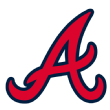
35-25 | Campeones del Este de la Liga Nacional | 7.6% de probabilidades de ganar la Serie Mundial
Posibilidades de ganar por ronda
BAÑO: 60,8% contra vinos tintos
NLDS: 70,7% contra marlines; 56,4% contra Cachorros
NLCS: 64,7% contra cerveceros; 58,3% contra cardenales; 39,4% contra Padres; 26,7% contra los Dodgers
WS: 65,5% frente a los Azulejos; 62,1% contra Astros; 50,7% frente a los Yankees; 50,6% contra indios; 47,5% contra White Sox; 49,5% frente a A; 44,2% contra rayos; 44,1% contra gemelos
¿Qué tan lejos podrían llegar? Las peleas de rotación y las lesiones plagaron a los Bravos por lo demás herméticos durante toda la temporada. El grupo sigue inseguro en los albores de la postemporada. Max Fried estuvo espectacular pero vuelve a subir tras una lesión. El novato Ian Anderson es guapo pero su historial es corto. Kyle Wright ha estado mejor últimamente, pero no ha demostrado que pueda ser consistente. Mike Soroka y Cole Hamels están fuera de temporada. La ofensiva y el bullpen de los Bravos son tan fuertes que Atlanta está en buena forma si los titulares pueden simplemente evitar que el otro equipo salte a grandes liderazgos iniciales. – – Doolittle
Cómo puedes irte a casa antes de terminar: La clave para el cuerpo de lanzadores podría ser mantener la pelota en el parque. Los lanzadores de Atlanta se ubicaron en el puesto 23 en tasa de strike, pero ningún equipo de lanzadores permitió una tasa más baja de carreras sobre jonrones (35%). Si pueden resistir hasta octubre, la defensa de equipo deficiente de los Bravos solo puede hacer mucho daño. La prevención de carreras no tiene que ser perfecta, ya que Atlanta puede tener la mejor ofensiva del béisbol. – – Doolittle
Héroe de octubre más probable: Freddie Freeman es el corazón y el alma de los Bravos y está mejor que nunca en tu plato. No solo encuentra potencia, sino también promedios y reduce sus golpes (tuvo más bases por bolas que K por primera vez). Sus números contra la derecha son ridículos este año por lo que será interesante ver si los equipos juegan a su alrededor tratando de que Marcell Ozuna los venza. – – Schönfield
Emparejamiento en la ronda 1: Buen bateador contra las bolas rápidas de Red. Bueno, esto será divertido. La segunda mejor ofensiva de las Mayores (los Dodgers se arrastraron en carreras por juego, 5.82-5.80, justo por delante de los Bravos) contra la dinámica rotación de los Rojos. Los Bravos lideraron las mayores contra rectas en WOBA, superando .304 y .547. El abridor del segundo juego, Luis Castillo, tuvo la segunda tasa de swing más alta entre sus abridores de rectas con un 37.1% (cuatro o dos plazas), pero los bateadores acertaron 0.300 y 0.525 contra sus rectas. El abridor del Juego 1, Trevor Bauer, tuvo una tasa de swing y fallos mucho menor (23%), pero los bateadores solo acertaron 0.141 contra su recta. – Schonfield
Tus únicas estadísticas para 2020: Para cualquier aficionado constantemente afectado por la incapacidad de su equipo favorito para mover a un corredor o ganar a un corredor con menos de dos outs, tenga la seguridad de que la ofensiva de los Bravos esta temporada tiene, con mucho, el porcentaje más bajo de outs “productivos”. – O adelanta a un corredor sin outs o anota un corredor con un out desde la tercera fila. Con corredores en tercer lugar con menos de dos outs, tendrán el peor récord cuando se lleven la carrera a casa. Mientras tanto, terminaron segundos en las mayores con casi seis carreras por juego, la mayoría de ellas desde el siglo XIX. – Miller
Una predicción audaz: Anderson será el primer novato de los Bravos en lanzar al menos seis entradas en un juego de playoffs. – – Passan
3. Cachorros de Chicago

34-26 | Campeones centrales de la Liga Nacional | 4.5% de posibilidades de ganar la Serie Mundial
Posibilidades de ganar por ronda
BAÑO: 63,9% contra marlines
NLDS: 57,7% contra vinos tintos; 43,6% contra Bravos
NLCS: 59,2% contra cerveceros; 52,5% contra cardenales; 33,9% contra Padres; 22.2% contra los Dodgers
WS: 60,0% frente a Blue Jays; 56,4% contra Astros; 44,9% frente a los Yankees; 43,7% frente a A; 42,3% contra indios; 39,4% contra White Sox; 38,5% contra rayos; 38,4% contra gemelos
¿Qué tan lejos podrían llegar? El núcleo de Chicago ha estado en su lugar durante mucho tiempo, y sus mejores jugadores, Anthony Rizzo, Kris Bryant y Javier Baez, son algunas de las estrellas más reconocidas del juego. Bryant regresó de su extraño cambio (y golpeó un grand slam) durante el fin de semana, por lo que todos los muchachos están haciendo fila para otra carrera de playoffs. Los Cachorros se abrieron camino más allá de una liga débil durante la temporada regular, con el trío muy por debajo de 0.700 la mayor parte del tiempo en OPS. Pero los cubículos clave tienen que golpear como osos si hay alguna esperanza de que se repita en 2016. – – Doolittle
Cómo puedes irte a casa antes de terminar: David Ross necesita encontrar a alguien que pueda responder a la llamada cuando vaya al bullpen para cerrar juegos. Craig Kimbrel podría ser ese tipo. No pudo. Su material sigue siendo retirado de sus días dominantes, pero no renunció a correr en septiembre. Después de todo, se le paga por hacer el cierre de los partidos, y no está claro si Rowan Wick (carga inclinada) puede cruzar la puerta del bullpen. Jeremy Jeffress hizo el trabajo durante la mayor parte de la temporada, pero sus indicadores de estadísticas subyacentes sugieren que Ross debería tener la mente abierta. – – Doolittle
Héroe de octubre más probable: Yu Darvish ha sido uno de los mejores abridores de las mayores desde la segunda mitad de 2019 cuando de repente comenzó a golpear la zona de strike como nunca antes. No tiene una gran reputación en los juegos, aunque su actuación en la Serie Mundial 2017 contra los Astros puede ser excusable. Sin embargo, el pitcheo de postemporada se trata de bates perdidos, y Darvish lo hace mejor que cualquier otro empleado de los Cachorros. – – Schönfield
Emparejamiento en la ronda 1: Yu Darvish y Kyle Hendricks contra los bateadores de los Marlins. Los Marlins se ubicaron en el puesto 25 en la tasa de persecución con las mayores, lo que significa que perseguirán lanzamientos fuera de la zona de strike. Darvish y Hendricks son dos de los mejores lanzadores de strike de las mayores. De hecho, Darvish enumeró todos los abridores calificados como un porcentaje de los lanzamientos dentro de la zona de strike (no es que fueran fáciles de golpear). Será interesante ver si los dos abridores de los cachorros se desvían de su horario habitual y lanzan más lanzamientos fuera del plato para ver si los marlins cazan. – – Schönfield
Tus únicas estadísticas para 2020: Los playoffs ampliados de este año resultarán en muchos datos divertidos que son malos para un equipo de playoffs. Pero los Cachorros no se escabulleron a través del formato expandido, en realidad ganaron su división, a pesar de que el promedio de bateo de su equipo es aproximadamente 15 puntos más bajo que cualquier otro equipo de postemporada en la historia. No es el final del pedido; Son las estrellas de los Cachorros, con Baez, Bryant y Kyle Schwarber en .200 o menos. Los cinco mejores asientos de los cachorros en orden: .211, .217, .204, .190, .211. – Miller
Una predicción audaz: La ofensiva de los Cachorros, positivamente miserable en septiembre con su barra de .215 / .299 / .340 que se asemeja a la línea de carrera del lanzador Zack Greinke, estallará en la serie de comodines, poniendo varios números torcidos. – – Passan
4. Padres de San Diego

37-23 | segundo lugar, NL Oeste | 11.1% de probabilidades de ganar la Serie Mundial
Posibilidades de ganar por ronda
BAÑO: 63,1% contra cardenales
NLDS: 70,4% contra cerveceros; 36,7% contra los Dodgers
NLCS: 80,4% contra marlines; 72,5% contra vinos tintos; 66,1% contra Cachorros; 60,6% contra Bravos
WS: 73,8% frente a los Azulejos; 70,7% contra Astros; 61,3% frente a A; 60,1% contra Yankees; 60,0% contra indios; 57,0% contra White Sox; 56,0% contra gemelos; 53,7% en comparación con los rayos
¿Qué tan lejos podrían llegar? Al comienzo de la temporada, el bullpen de los Padres era la principal preocupación, según Kirby Yates. Según FanGraphs, los auxiliares renovados de San Diego han estado liderando las mayores en el Bullpen WAR desde el 1 de septiembre. El crimen ha colapsado levemente últimamente, y eso es preocupante cuando las sequías de Eric Hosmer, Fernando Tatis Jr. y otros se convierten en octubre. En particular, las recientes lesiones de Mike Clevinger y Dinelson Lamet han puesto a trabajar a la rotación, ya sea que puedan caminar o no. Porque cuando los titulares de los Padres actúan en la postemporada, este es un equipo completo que puede enfrentarse cara a cara con cualquiera. Bueno, excepto quizás los Dodgers. Quizás el abrumador dilema de los Padres es que los Dodgers hacen todo lo que hacen un poco mejor. – – Doolittle
Cómo puedes irte a casa antes de terminar: Acerca de esta alineación … De acuerdo con las principales métricas de equipo contextualizadas, los Padres fueron uno de los 5 mejores clubes ofensivos. El hecho de que el papel se haya ralentizado un poco en las últimas semanas es más importante que un indicador claro del destino que se avecina. Otra cosa sobre la ofensiva de los Padres es que solo un equipo confió más en Homer en su anotación que San Diego. Eso no tiene por qué ser algo malo. Todos los equipos líderes en la categoría de delitos basados en Homer son equipos ganadores. Sin embargo, cuando las fuentes de energía se reducen por caídas en el momento oportuno y lanzamientos en el calibre de los playoffs, la incapacidad de los padres para rotar el marcador puede hacer que el regreso de los padres a los playoffs sea corto. – – Doolittle
Héroe de octubre más probable: Por mucho que amemos a Tatis, su caída al final de la temporada es motivo de preocupación y lo ha hecho mucho mejor contra equipos malos. Así que vayamos con Lamet. La historia de la postemporada está llena de lanzadores de poder jóvenes que triunfan (aunque él no tiene 28 los joven). Piense en lanzadores como José Rijo para los Rojos en 1990 o Josh Beckett para los Marlins en 2003 o Nathan Eovaldi para los Medias Rojas en 2018. La experiencia de postemporada está sobrevalorada y Lamet tuvo una gran temporada regular, perdiéndose un montón de bates y tiene la gran combinación de control deslizante de bola rápida / eliminación. – – Schönfield
Emparejamiento en la ronda 1: Fernando Tatis Jr. y Jake Cronenworth contra el lanzador de los Cardenales. Tatis fue el líder MVP fugitivo después del primer mes de la temporada, pero bateó .208 / .311 / .403 en septiembre. Cronenworth fue el novato fugitivo del año después de los primeros 30+ juegos, pero bateó .183 / .275 / .268 en septiembre. – – Schönfield
Tus únicas estadísticas para 2020: Los White Sox de 1977 colocaron a sus receptores en el último lugar de la orden de strike y aparentemente nunca volvieron a considerar esa decisión. El resultado, cuando estos receptores (Jim Essian y Brian Downing) tuvieron grandes años cada uno, fue un OBP de 0.375 en el número 9, el más alto de la historia. Los Padres este año, sin bateo de lanzadores, han superado este récord. Sus jugadores n. ° 9 (10 jugadores diferentes comenzaron en este punto, con Jurickson Profar tomando la delantera) tienen un OBP de 0.385. Es en parte evidencia de la profundidad de la alineación de los Padres, y en parte sólo una de esas cosas raras, considerando que los bateadores N ° 9 en realidad superaron a los bateadores de limpieza del club. – Miller
Una predicción audaz: Lo más impresionante de los padres no será su poder ofensivo ni su pitcheo. Será un bullpen liderado por Trevor Rosenthal, Drew Pomeranz y Austin Adams, quien recientemente regresó de una cirugía de rodilla equipada con su devastador empujador. – – Passan
5. Cardenales de San Luis

30-28 | segundo lugar, NL Central | 1.9% de probabilidades de ganar la Serie Mundial
Posibilidades de ganar por ronda
BAÑO: 36,9% contra Padres
NLDS 54,3% contra cerveceros; 24,4% contra los Dodgers
NLCS: 67,2% contra marlines; 57,2% contra vinos tintos; 47,5% contra Cachorros; 41,7% contra Bravos
Series Mundiales: 58.8% contra Blue Jays; 55,2% contra Astros; 42,4% frente a A; 41,2% frente a los Yankees; 41,1% contra indios; 38,1% contra White Sox; 37,3% contra rayos; 37,2% contra gemelos
¿Qué tan lejos podrían llegar? Los Cardinals tienen que mantener los puntajes bajos, incluso más bajos de lo que normalmente se ve en una competencia cerrada de postemporada. Para ello, tienen que mantener la pelota en el patio. St. Louis ocupó el quinto lugar en la limitación de carreras por juego por cualquier medio que no sea un jonrón. Estaban más en el medio del campo cuando se trataba de permitir carreras de jonrones. Si miras a los equipos en el Camino de los Cardinals – los Padres, los Dodgers, casi cualquier club en la postemporada – muestran ataques construidos alrededor de la pelota larga. Si tan solo los cardenales pudieran jugar contra ellos mismos. – – Doolittle
Cómo puedes irte a casa antes de terminar: St. Louis necesita desesperadamente lanzar algunas bombas. Los cardenales tienen una rotación confiable, aunque poco espectacular. El bullpen estaba en el flujo, pero de repente parece una fortaleza cuando Alex Reyes se transforma en el nuevo Mariano Rivera. La ofensiva no fue buena, pero juntos los jugadores de St. Louis se ponen a tierra con un clip aceptable. Aquí es donde comienzan los problemas: los Redbirds terminaron 27 en slugging y últimos en jonrones y poder aislado. Es difícil anotar en la postemporada y los equipos necesitan algunos jonrones para sobrevivir. La buena noticia es que con gente como Paul Goldschmidt, Matt Carpenter, Paul DeJong y Yadier Molina, St. Louis tiene matones que son capaces de llegar más lejos. Si no lo hacen, los Cardinals no anotarán lo suficiente para derrotar a las bestias de la Liga Nacional. – – Doolittle
Héroe de octubre más probable: Mira, si los cardenales ganan, los héroes nunca son quienes esperabas. En 2006, el MVP de la NLCS fue Jeff Suppan y el MVP de la Serie Mundial fue David Eckstein. En 2011 David Freese se llevó a casa ambos premios. El MVP de la NLCS 2013 fue el novato Michael Wacha. Así que probablemente estemos mirando a Brad Miller, un hombre que ha sido liberado por los Cerveceros y los Dodgers en los últimos años, abandonado por los Indios y abandonado por los Yankees por dinero en efectivo. – – Schönfield
Emparejamiento en la ronda 1: RISP versus RISP. Los Padres lideraron las mayores promediando 0.310 y 0.569 con corredores en posición de gol (¡piense en todos esos Grand Slams!). Los Cardinals cedieron un promedio de .222 en RISP, el segundo más bajo entre las mayores de los Dodgers. Adam Wainwright fue particularmente bueno en esto, manteniendo a los bateadores en un promedio de 0.171 y un slugging de 0.195. – – Schönfield
Tus únicas estadísticas para 2020: El 1 de septiembre, 11-0, Andrew Knizner se enfrentó a Goldschmidt y conectó un sencillo en el medio. Este es el único golpe emergente de los Cardinals este año. Juntos son 1:29 para una línea de .034 / .125 / .034. (Técnicamente, podría ser peor; los ganadores del premio de los Diamondbacks son 0 contra 22, pero con un porcentaje base más alto). – Miller
Una predicción audaz: Jack Flaherty conectará al menos 10 bateadores en su primera apertura en esta postemporada. – – Passan
6. Miami Marlins

31-29 | segundo lugar, NL Este | 0.5% de probabilidades de la Serie Mundial
Posibilidades de ganar por ronda
BAÑO: 36,1% contra Cachorros
NLDS: 42,5% contra vinos tintos; 29,3% contra Bravos
NLCS: 39,1% contra cerveceros; 32,8% contra cardenales; 19,6% contra Padres; 11,5% contra los Dodgers
WS: 38,8% contra Astros; 39,9% contra Azulejos; 27,3% frente a A; 26,2% frente a los Yankees; 26,2% contra indios; 23,7% contra los White Sox; 23,1% contra rayos; 23,0% contra gemelos
¿Qué tan lejos podrían llegar? Los Marlins irán a correr si pueden canalizar la magia de los dos únicos equipos anteriores de South Beach para la postemporada. Miami es una de las grandes historias de la temporada y esta fue una temporada en la que necesitábamos grandes historias. Pero como todo buen Gen-Xer sabe, la realidad muerde. Los Marlins llegaron a 500 y consiguieron un lugar en los playoffs a pesar del peor diferencial de carreras en el Este de la Liga Nacional. Sin embargo, siempre hay esperanza. Las carreras memorables por el título de 1997 y 2003 fueron impulsadas por lanzadores jóvenes que estaban calientes en el momento adecuado. En Sixto Sánchez, Pablo López, Sandy Alcantara y Trevor Rogers, los Marlins 2020 tienen los ingredientes adecuados para recrear exactamente esta receta. – – Doolittle
Cómo puedes ir a casa antes de terminar: Los marlins han sido prohibidos con tanta frecuencia como cualquier delito de béisbol. Son un equipo sin una fuerza ofensiva clara, solo un grupo de tipos veteranos que ponen el talento suficiente para darle una oportunidad al cuerpo de lanzadores la mayoría de las noches. Contra los lanzadores de élite, es una caminata por la cuerda floja que hay que superar. No es difícil imaginar un escenario en el que los Marlins se mantengan firmes durante algunos juegos, pero simplemente no pueden poner números torcidos en el tablero lo suficiente para seguir adelante. Alguien de este grupo olvidado tiene que ponerse caliente. – – Doolittle
Héroe de octubre más probable: Tenemos que ir con Sánchez porque si los Marlins hacen algo, probablemente será porque el pitcheo inicial se pone en marcha. Además, Sánchez encaja perfectamente con la historia de los marlins. Livan Hernández era un novato de 22 años en 1997 cuando ganó los honores de Jugador Más Valioso de la Serie Mundial y la Liga Nacional. Josh Beckett tenía 23 años, un lanzador de segundo año en 2003, cuando los Marlins ganaron todo nuevamente. Sánchez tiene solo 22 años y tiene menos de 10 aperturas en su carrera, pero las mejores personas. – – Schönfield
Emparejamiento en la ronda 1: Los Marlins no son un equipo de gran poder, pero ocuparon el segundo lugar detrás de los Padres en bases robadas. Veamos si Don Mattingly intenta insultar a los caminos base. El utilitario Jon Berti, que comenzó en la segunda base de la pista, es la mayor amenaza. Starling Marte, Lewis Brinson y Miguel Rojas también corren peligro de correr. – – Schönfield
Tus únicas estadísticas para 2020: Gracias a las cuarentenas, los dobles cabezazos de maquillaje y los intercambios a mitad de temporada, los Marlins utilizaron a 61 jugadores, incluidos 37 lanzadores, la mayor cantidad en la historia de la franquicia, a pesar de la corta temporada. Muchos de estos lanzadores solo trabajaron una entrada o cinco y se mantuvieron en una pregunta de trivia de la franquicia futura mientras que colectivamente prendieron fuego a las estadísticas de lanzamiento del club. Los 15 marlins que han lanzado la mayor cantidad de entradas este año tuvieron una efectividad colectiva de 4.23, lo que los colocaría en la mitad superior de la liga. Los 22 jugadores a corto plazo tuvieron una efectividad por encima de las 7:00 a.m., lo que llevó la efectividad general del club a casi las 5:00 a.m., una imagen ligeramente sesgada y algo engañosa del personal de postemporada de los Marlins. – – Müller
Una predicción audaz: Los Marlins no inician a su talentoso novato Sánchez en el juego 1 de la serie de comodines. – – Passan
7. Rojos de Cincinnati
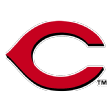
31-29 | NL séptimo favorito | 1.7% de probabilidades de la Serie Mundial
Posibilidades de ganar por ronda
BAÑO: 39,2% contra Bravos
NLDS: 60,4% contra marlines; 42,3% contra Cachorros
NLCS: 49,5% contra cerveceros; 42,8% contra cardenales; 27,5% contra Padres; 17.3% contra los Dodgers
WS: 50,3% contra Blue Jays; 49,2% contra Astros; 36,6% frente a A; 35,4% frente a los Yankees; 35,4% contra indios; 32,5% contra White Sox; 31,8% contra rayos; 31,7% contra gemelos
¿Qué tan lejos podrían llegar? Afortunadamente para los fanáticos de los Rojos, cuando la ofensiva unidimensional de Cincinnati toma un par de empujones largos, su club ingresa a los playoffs con uno de los mejores lanzadores para mantener una ventaja inicial. La rotación funciona en profundidad, liderada por los tres grandes de Trevor Bauer, Luis Castillo y Sonny Gray, lo que debería permitir al manager David Bell analizar entradas de alto apalancamiento a medida que los Rojos avanzan a las rondas posteriores, levantando así sus brazos superiores del bullpen. permanecer. Eso es todo lo que necesitan los Rojos, un par de jonrones aquí y allá. Si los titulares de los Rojos obtienen un mínimo de apoyo para correr, Cincinnati será un oponente de playoffs de pesadilla para cualquier equipo, como sugirió Joey Votto. – – Doolittle
Cómo puedes ir a casa antes de terminar: En esta era de muchas carreras en casa, se puede decir que cada equipo tiene que hacer carreras en casa para hacerlo bien en los playoffs. Puedes decir eso para cualquier equipo, pero no será tan cierto para todos los equipos como lo es para los Rojos. En pocas palabras, este es uno de los equipos ofensivos más extremos de la historia del béisbol. Los Rojos terminaron con un promedio de bateo históricamente bajo que pertenece a las tarjetas de béisbol de color sepia emitidas por las compañías tabacaleras. Obtuvieron el puesto 21 en wRC + pro FanGraphs, por nombrar solo una medida relacionada con el contexto. Que lo hicieron tan bien como lo hicieron se debió a una ofensiva basada en Homer que terminó quinto en las carreras por juego sobre Homer. Desafortunadamente, los Rojos fueron los últimos en terminar una milla en carreras que no eran de Homer. Cincinnati tiene que vencer a Homer o no sobrevivirá sin importar lo bueno que sea el equipo de lanzadores. – – Doolittle
Héroe de octubre más probable: El brazo de goma de Bauer significa que puede sumergirse profundamente en los juegos y tomar un breve descanso o incluso jugar con alivio, pero los Rojos necesitarán comenzar desde algún lugar y después de un terrible primer mes, Eugenio Suárez ha regresado a las carreras de casa como lo hizo en hizo la temporada pasada cuando alcanzó los 49. Lleva liderando las mayores en carreras en casa desde la segunda mitad de 2019. – Schönfield
Emparejamiento en la ronda 1: Bateador de los Rojos contra BABIP. Los Rojos batearon solo 0.212, el promedio más bajo de un equipo de playoffs y el segundo promedio más bajo (los Medias Blancas de 1910 batearon 0.210). Pero los Rojos también terminaron con un promedio de 0.245 bolas en el juego, el más bajo desde los Yankees de 1968. Según las métricas de Statcast, su promedio de bateo esperado debería haber sido 0.242 basado en la calidad del contacto. Tal vez eso hubiera representado más de 162 juegos. Los Rojos lo necesitan para nivelar en los próximos dos o tres juegos (y con suerte más allá). – – Schönfield
Tus únicas estadísticas para 2020: En una temporada de tantos hechos entretenidos y de bajo promedio de bateo, este es el más divertido y el menos divertido de todos: el promedio de bateo de los Rojos en las pelotas en juego es insondable .245, el puntaje más bajo de cualquier equipo desde The Pitcher’s 1968 el segundo más bajo desde el final de la era del deadball en 1920, asombrosos 20 puntos menos que cualquier otro equipo en el béisbol ese año, y un punto mejor que los lanzadores el año pasado. Los Rojos son cuartos en la Liga Nacional en Homern, segundos en la Liga Nacional en boletos y segundos desde el fondo en la clasificación. (Bonus Reds stat: Ihre Schläger Nr. 7-8-9 haben einen höheren OPS als ihre Schläger Nr. 1-2 oder ihre Schläger Nr. 3-4-5-6.) – Müller
Eine kühne Vorhersage: Der Bullpen der Roten wird zu Beginn der Nachsaison einen Vorsprung ausbauen und das Glück des Teams gefährden, in einer kurzen Serie mit überlegenem Startpitching zu sein. – – Passan
8. Milwaukee Brewers

29-31 | NL achte Saat | 0,7% World Series Gewinnchancen
Gewinnchancen nach Runde
TOILETTE: 24,6% gegen Dodgers
NLDS: 45,7% gegen Kardinäle; 29,6% gegen Padres
NLCS: 60,9% gegenüber Marlins; 50,5% gegen Rotweine; 40,8% gegen Cubs; 35,3% gegen Braves
WS: 52,1% gegenüber Blue Jays; 48,4% gegen Astros; 37,1% gegenüber Yankees; 36,0% gegenüber A’s; 34,7% gegenüber Indern; 31,9% gegen White Sox; 31,2% gegenüber Strahlen; 31,0% gegen Zwillinge
Wie sie weit gehen könnten: Der Schlüssel für die Brauer könnte kaum einfacher sein: Sie müssen den Ball mit einer Leine auf die Rückseite des Bullpen bringen. Natürlich mag das Ziel einfach sein, aber die Schritte, um es zu erreichen, sind unglaublich komplex. Milwaukees Starter müssen den Ball zu Josh Hader und Devin Williams gegen die unlösbare Offensive der Dodgers bringen. Die gute Nachricht ist, dass sie Brandon Woodruff in einem der Wildcard-Spiele einsetzen können. Die schlechte Nachricht ist, dass sie mit Co-Ass Corbin Burnes, der mit einer schrägen Belastung konfrontiert ist, nicht dasselbe tun können. Und selbst wenn Milwaukees Pitching Nullen aufreihen kann, muss ein Team, das als Einheit .223 traf, einige Runs gegen einen Elite-Pitching-Stab durchführen. – – Doolittle
Wie sie nach Hause gehen könnten, bevor Sie fertig sind: Angesichts der offensiven Kämpfe der Brewers könnte ein früher Homer mit drei Läufen, der von einem Starter zugelassen wurde, sie versenken und ihren leistungsstarken Bullpen aus den Möglichkeiten mit hohem Hebel herausholen. Wer liefert am ehesten den benötigten Lead? Das wäre der ehemalige MVP Christian Yelich, der seine schlechteste Saison hinter sich hat. Es ist kein Problem, die Brewers als fehlerhaftes Team zu bezeichnen. Immerhin haben sie die Playoffs mit einem Verlustrekord gemacht. Aber es scheint nur wenige Szenarien zu geben, in denen Milwaukee einen Aschenputtellauf ohne einen plötzlich wiederauflebenden Yelich unternimmt. – – Doolittle
Höchstwahrscheinlich Oktoberheld: OK, vielleicht sind es Yelich oder Ryan Braun in seinem Schwanengesang in Milwaukee (er hat eine Cluboption für 2021, die möglicherweise nicht aufgegriffen wird), aber lassen Sie uns mit Daniel Vogelbach eine Milwaukee-Legende werden und die Unterwelt anführen -.500 Brauer zu ihrer ersten World Series. Sicher, die Mariners haben ihn gegen Bargeld zu den Blue Jays geschickt, und die Blue Jays haben ihn nach ein paar Spielen aufgegeben, aber er ist heiß und hat in 19 Spielen mit den Brewers .328 / .418 / .569 geschlagen. – – Schönfield
Matchup in Runde 1: Hader und Williams gegen Dodgers Hitter. Wirklich, Craig Counsell muss seine beiden Ass-Helfer so hart wie möglich arbeiten – einschließlich der Verwendung vor dem achten Inning, wenn das Spiel auf dem Spiel steht. In der Tat, wenn die Brewers nach fünf Innings im Opener auf sind, sollte er nicht davor zurückschrecken, beide für zwei Innings pro Stück zu verwenden, wenn das Spiel auf der Linie ist. Denken Sie daran, dass zwischen dem letzten Spiel der Wildcard-Serie und dem ersten Spiel der NLDS mindestens drei freie Tage liegen, sodass Sie sie für drei Spiele stark nutzen können. – – Schönfield
Ihre einzige Statistik für 2020: Die Offensive der Brewers war schrecklich – nur ihre Rechtsverteidiger trafen besser als der Ligadurchschnitt für ihre Position – aber sie schafften es trotzdem, genug Runs zu erzielen, um die Playoffs zu erreichen. Ihr Trick? Sie treffen viel, viel besser mit Männern auf der Basis und bündeln ihre wenigen Treffer genug, um Läufe zu erzielen. Nur ein Team in diesem Jahrhundert – die Cardinals 2013 – hatte eine größere Beeinträchtigung in ihrer Offensive mit Läufern auf der Basis als die Brewers, was ihnen half, in diesem Jahr einen leicht respektablen 13. Platz in der NL zu erreichen. – – Müller
Eine kühne Vorhersage: Brewers Reliefs werden die Nachsaison mit mehr Innings beenden als ihre Startkrüge, was angesichts der Geschichte von Craig Counsell, sich auf seinen Bullpen zu verlassen, vielleicht nicht ganz mutig ist, aber dennoch eine seltsame Realität ist. – Passan
Amerikanische Liga
1. Tampa Bay Rays

40-20 | AL Ostchampions | 8,8% World Series Gewinnchancen
Gewinnchancen nach Runde
TOILETTE: 64,8% gegenüber Blue Jays
ALDS: 54,9% gegenüber Yankees; 54,9% gegenüber Indern
ALCS: 66,3% gegen Astros; 56,5% gegenüber A; 52,1% gegen White Sox; 51,1% gegen Zwillinge
WS: 76,9% gegen Marlins; 68,8% gegen Brauer; 68,2% gegen Rotweine; 62,7% gegen Kardinäle; 61,5% gegen Cubs; 55,8% gegen Braves; 46,3% gegen Padres; 30,6% gegen Dodgers
Wie sie weit gehen könnten: Sie schreiben nicht wirklich vor, dass ein Team viele enge Spiele spielt, aber das bleibt ein Spieltyp, der die Strahlen zu bevorzugen scheint. Sie werfen auf. Sie fangen. Sie treffen rechtzeitige Homer. Tampa Bay versucht immer, diskrete Matchups zu maximieren, aber wenn man sich vier mögliche Runden der Playoffs und die Anzahl der Verletzungen ansieht, die die Pitching-Tiefe der Rays beeinträchtigt haben, scheint es, dass Tampa Bay es bis zur Ziellinie schafft muss etwas Länge von seinen Startern bekommen. Wenn Charlie Morton, Tyler Glasnow und Blake Snell sowohl effektiv als auch effizient sind, achten Sie darauf. – – Doolittle
Wie sie nach Hause gehen könnten, bevor Sie fertig sind: Die Strahlen sehen viele Stellplätze und jagen als Gruppe nicht viel. Wenn sie schwingen, macht nur ein Schläger einen geringeren Prozentsatz an Kontakt. But when contact is made, damage is done. Only three teams have a higher slugging percentage on contact than Tampa Bay. Whether it’s hard stuff, soft stuff or breaking stuff, the Rays seek to force a pitcher into the zone, then they jump on him. Alas, patience can lapse into passivity, and when you go against postseason-ready pitching staffs, it can become a vice. The Rays need to balance aggression and patience before called third strikes start leading to a string of zeros. — Doolittle
Most likely October hero: No team wants to face Glasnow in the postseason, even if his 2020 ERA didn’t match the 1.78 figure he put in 12 starts in 2019. Still, here’s the number that stands out: 14.6 K’s per nine innings. Whoa. Yeah, when you’re 6-foot-8 and average 97 mph with a high-spin fastball and wipeout breaking ball, you’re going to rack up the K’s. He did give up some home runs, his command was shaky at times and the Rays were careful with his pitch count (more than 100 pitches only twice), but he is the swing-and-miss type pitcher who can dominate for a month. — Schoenfield
Matchup to watch in Round 1: Strikeouts versus strikeouts. Rays pitchers led the AL in strikeouts — as Kevin Cash alluded to after Aroldis Chapman threw at the Rays in an early September game, the Rays “have a whole damn stable of guys who throw 98 mph” — but only the Tigers struck out at a higher rate across MLB. The offense also had one of the highest walk rates, however, as the Rays have morphed into a real “three true outcomes” type of lineup. — Schoenfield
Their only-in-2020 stat: The Rays rarely let their starters face batters three (or more) times in a start, and their own hitters show the reason why: Tampa Bay hitters have slugged over .560 against starters the third time around. Rays hitters are collectively 47% better the third time through the order than they are overall, which is the AL’s biggest third-time-through bump since 2000. — Miller
One bold prediction: Reliever Nick Anderson will win ALCS MVP. — Passan
2. Oakland Athletics
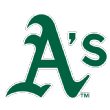
36-24 | AL West champs | 4.8% World Series odds
Odds by round
WC: 49.0% vs. White Sox
ALDS: 60.2% vs. Astros; 46.8% vs. Twins
ALCS: 64.9% vs. Blue Jays; 50.0% vs. Yankees; 49.9% vs. Indians; 43.5% vs. Rays
WS: 72.7% vs. Marlins; 64.0% vs. Brewers; 63.4% vs. Reds; 57.6% vs. Cardinals; 56.3% vs. Cubs; 50.5% vs. Braves; 38.7% vs. Padres; 26.2% vs. Dodgers
How they could go far: A long run in the postseason for Oakland would seem to require two things: a competent performance from the Athletics’ middle-of-the-pack rotation, and third baseman Jake Lamb continuing his impressive Matt Chapman imitation. The rotation question has plagued Oakland through its run of success in recent years. This time around, there are good options, even if we don’t quite know how things will set up. Chris Bassitt, Jesus Luzardo and Sean Manaea all figure to be key parts of the puzzle. As for Lamb, who was set adrift by Arizona, he actually has hit better than Chapman did before the latter’s season was cut short by injury. He also has played a mistake-free third base, albeit without Chapman’s all-world zeal at the position. — Doolittle
How they could go home before you’re done reading this: The A’s led the majors with a sub-2.50 bullpen ERA and feature one of the game’s best closers in Liam Hendriks. But as mentioned, the rotation is more competent than spectacular, and the offense likewise has been middling. If Oakland can take leads into the middle innings, it will be a tough out for any opponent. Otherwise, it’ll be up to a .220-ish hitting offense to save the day. Getting lots of early leads seems like the surer path. — Doolittle
Most likely October hero: There’s no obvious answer here, but let’s go with Hendriks, who has basically been lights out now for two seasons. The bullpen is the team’s strength, so if the A’s win it will be because the pen locks down every lead they get. Bob Melvin has used Hendriks more than one inning in only a couple of outings, but he did do it regularly last season, so he’s certainly couple of four- or five-out saves. — Schoenfield
Matchup to watch in Round 1: A’s hitters versus breaking balls. The A’s were middle of the pack against four-seam fastballs, but only the Rangers and Reds had a lower batting average than Oakland’s .173 mark against curveballs and sliders. Matt Olson and Marcus Semien both hit under .150 against breaking balls. — Schoenfield
Their only-in-2020 stat: No matter how you split it up, the A’s bullpen looks pretty good — the team had, after all, the league’s best bullpen ERA. But the relievers were especially good with one day of rest, with a 1.52 ERA that’s the best by any bullpen since 1988. The bad news is that, with urgency of October baseball and this year’s compressed postseason schedule, Oakland might not have the luxury of having many days of rest. — Miller
One bold prediction: The A’s best hitter this postseason will be catcher Sean Murphy, who has been under-the-radar excellent in his first taste of full-time duty and is a burgeoning All-Star. — Passan
3. Minnesota Twins

36-24 | AL Central champs | 8.7% World Series odds
Odds by round
WC: 62.5% vs. Astros
ALDS: 56.1% vs. A’s; 52.3% vs. White Sox
ALCS: 69.7% vs. Blue Jays; 55.4% vs. Yankees; 55.3% vs. Indians; 48.9% vs. Rays
WS: 77.0% vs. Marlins; 69.0% vs. Brewers; 68.3% vs. Reds; 62.8% vs. Cardinals; 61.6% vs. Cubs; 55.9% vs. Braves; 44.0% vs. Padres; 30.7% vs. Dodgers
How they could go far: Minnesota doesn’t have the most diverse offense of teams in the postseason. Not only do the Twins lean heavily on long hits to score runs, they do the majority of that damage against right-handed pitchers. The Twins led the American League in overall home run percentage. They also led the league in HR% off righties, and it wasn’t particularly close. The numbers were polar opposite against left-handers: Minnesota finished dead last in the AL in HR% off lefties. Thus the Twins have two choices: solve southpaws, or avoid them. The strengths of several of Minnesota’s possible playoff obstacles suggest taking the former path. — Doolittle
How they could go home before you’re done reading this: As we all remember, the Twins set the team home run record during the 2019 season. This season, they are among the leaders in team homers but are just one of the top-tier clubs, not above them. Yet, the Minnesota attack has been more dependent on homers for scoring than any other team on the AL side of the tournament, with 51% of the Twins’ runs coming via the long ball. Conversely, no team in the AL — playoff entrant or not — has scored fewer runs per game by non-homer means. The Twins need to go deep during games to go deep into the tournament. — Doolittle
Most likely October hero: Nelson Cruz was not only the best hitter on the Twins during the regular season, but he has been one of the best sluggers in postseason history. He has hit .287/.354/.659 in 44 postseason games, with 17 home runs and 35 RBIs, most memorably hitting six home runs in the 2011 ALCS for the Rangers. Granted, most of that came earlier in his career (he has played in only one postseason since 2014), but he’s arguably better than ever at the plate. — Schoenfield
Matchup to watch in Round 1: Twins batters versus Zack Greinke. After a hot start, Game 1 starter Greinke gave up at least three runs in each of his final seven starts (5.73 ERA). Batters hit .321 and slugged .536 against Greinke’s four-seamer — the pitch he throws most often. The Twins best hitters against four-seam fastballs: Cruz slugged .868 and Miguel Sano slugged .635. — Schoenfield
Their only-in-2020 stat: There are a lot of things that separate the teams at the top of the AL Central from the bottom, but here’s one: When a runner gets to third base with fewer than two outs this year, Tigers pitchers have been able to strike out the batter 10% of the time. The Twins, meanwhile, have struck that batter out 30% of the time, best in baseball. — Miller
One bold prediction: The Twins will win a playoff game. That’s not bold, you say? Considering they have lost their past 16, I’d posit that it more than qualifies, thank you very much. — Passan
4. Cleveland Indians
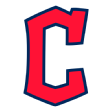
35-25 | second place, AL Central | 6.5% World Series odds
Odds by round
WC: 52.1% vs. Yankees
ALDS: 64.3% vs. Blue Jays; 45.1% vs. Rays
ALCS: 62.7% vs. Astros; 48.2% vs. White Sox; 50.1% vs. A’s; 44.7% vs. Twins
WS: 73.8% vs. Marlins; 65.3% vs. Brewers; 64.6% vs. Reds; 58.9% vs. Cardinals; 57.7% vs. Cubs; 51.9% vs. Braves; 40.0% vs. Padres; 27.3% vs. Dodgers
How they could go far: The Indians keep opponents off the scoreboard as well as anyone. That’s the good news. The bad news is that there isn’t much they do well on offense beyond draw walks. It’s possible that red-hot star Jose Ramirez keeps raking and carries the attack, and is even joined by his infield star cohort, Francisco Lindor. Beyond them, Indians hitters need to keep drawing free passes, move runners and come through in scoring situations, which they did not do well during the regular season. — Doolittle
How they could go home before you’re done reading this: If the starters falter, particularly Shane Bieber, Cleveland is doomed. This is pretty straightforward. The Indians lean on their rotation as much as any team in baseball. As a group, Cleveland pitchers have given up the fewest runs per game on home runs — a key metric for the postseason. But they also led the majors in limiting runs allowed by means other than the long ball. The Indians are just hard to score against. Any lengthy Cleveland run involves those trends continuing after the October leaves have turned. — Doolittle
Most likely October hero: If you’re picking one pitcher to go all Madison Bumgarner this postseason, you have to pick Bieber, the most dominant pitcher in the regular season. I don’t know if Terry Francona (or acting manager Sandy Alomar Jr.) would consider using him on short rest at any point the way he did with Corey Kluber three times in the 2016 postseason, but if the Indians go deep into October, it’s probably because Bieber is winning some low-scoring games. — Schoenfield
Matchup to watch in Round 1: Indians “power” hitting versus Yankees pitching. Cleveland ranked just 26th in the majors in isolated power — but Yankees pitchers gave up 83 home runs, fifth worst in the majors and the most of any playoff team. Gerrit Cole (14 in 73 IP), Masahiro Tanaka (nine in 48 IP) and J.A. Happ (eight in 49⅓ IP) were all vulnerable to the long ball. — Schoenfield
Their only-in-2020 stat: Cleveland’s catchers have the worst offensive production of any team’s catchers in at least 100 years. But Roberto Perez, Austin Hedges and Sandy Leon might be the best defensive catchers any team has ever gathered, and they have coaxed Cleveland’s pitching staff to the league’s best ERA+ in at least 100 years. Cleveland’s catchers have the American League’s best caught-stealing rate, the fewest passed balls (zero!) and are close to the bottom in wild pitches. Perez and Hedges are also both elite-level pitch framers. Their collective batting line — .128/.242/.189 — is almost impossible to believe, barely better than pitchers used to hit. But depending on how much of the pitching staff’s success you credit to the batterymates, it might be worth it. — Miller
One bold prediction: In a postseason game, Bieber will give up more runs than he has in any of his other 2020 starts. (The target number: four or more. Yes, Bieber, he of the 1.68 ERA, limited opponents to three or fewer runs in all 12 of his starts this season.) — Passan
5. New York Yankees

33-27 | second place, AL East | 5.0% World Series odds
Odds by round
WC: 47.9% vs. Indians
ALDS: 64.2% vs. Blue Jays; 45.1% vs. Rays
ALCS: 62.6% vs. Astros; 50.0% vs. A’s; 45.6% vs. White Sox; 44.6% vs. Twins
WS: 73.8% vs. Marlins; 65.2% vs. Brewers; 64.6% vs. Reds; 58.8% vs. Cardinals; 55.1% vs. Cubs; 49.3% vs. Braves; 39.9% vs. Padres; 27.2% vs. Dodgers
How they could go far: The Yankees don’t have a completely one-dimensional offense, but we’ve seen what they do best: club the ball over the fence. After injuries cast their season into temporary peril, the Bombers got mostly healthy and the homers started piling up like tote bags at a literary festival. And yet, established sluggers Giancarlo Stanton, Aaron Judge and Gary Sanchez haven’t added much to the long-ball surge. Sanchez might be on the outs, but if Stanton and Judge both get hot, there might be no one who can outscore the Yankees. — Doolittle
How they could go home before you’re done reading this: Given the explosiveness of the offense and the depth of the fireballing bullpen, the Yankees’ starters don’t have to work deep. There is one exception to that in Gerrit Cole. Cole hasn’t been quite as dominant as he was in 2019, but he has been pretty good and the Yankees need him to be at his best in the weeks to come. With four rounds to traverse and no rest days during series, Cole is going to have to be a one-man breather for the relief staff, going at least seven innings and shortening games. If Cole isn’t quite himself and gets bitten by the long-ball bug as he has at times during the regular season, it’ll be hard for the Yankees to survive the rugged AL bracket. — Doolittle
Most likely October hero: Cole is the easy choice and he looks locked in heading into October, but let’s go with DJ LeMahieu, who might have a claim for AL MVP honors if not for a two-week stint on the IL. LeMahieu is the kind of hitter who can excel in the postseason not only because he’s a high-average hitter with some pop, but because he doesn’t strike out. Only Tommy La Stella among qualified regulars had a lower strikeout rate. — Schoenfield
Matchup to watch in Round 1: So how do you beat Shane Bieber? He doesn’t give up many hits, walks about two batters per nine innings and averaged 14.2 K’s per nine. You can try to run up his pitch count — he had two five-inning starts this year with 103 and 98 pitches. But if you try to work the count and get to two strikes, batters hit just .096. He did give up seven home runs in 77⅓ IP, but even then they came off four different pitches, so it’s not as if he’s particularly vulnerable to a 1-0 fastball or something if he falls behind in the count. His least effective pitch was his cutter, against which batters hit .289/.325/.474. So, umm, yeah, we don’t know how you beat him either. — Schoenfield
Their only-in-2020 stat: Since 1993, the 20 largest splits between a team’s offense at home and its offense on the road: 19 Rockies seasons, and this year’s Yankees. Sanchez’ OPS is 300 points higher at home than on the road; Luke Voit’s is 400 points higher at home; LeMahieu’s is 500 points higher. Unlike those Rockies splits, the difference isn’t offset on the pitching side, as Yankees pitchers have given up 1.75 fewer runs per game at home. Alas, they’ve played their final home game of 2020. — Miller
One bold prediction: The Yankees will not go to the World Series, marking 11 consecutive years and tying the second-longest drought in franchise history. The darkest time for the franchise: The 13 years from 1982 to 1995 during which champions were crowned and the Yankees weren’t once in the picture. — Passan
6. Houston Astros
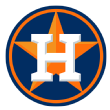
29-31 | second place, AL West | 1.5% World Series odds
Odds by round
WC: 37.5% vs. Twins
ALDS: 39.8% vs. A’s; 36.2% vs. White Sox
ALCS: 52.4% vs. Blue Jays; 37.4% vs. Yankees; 37.3% vs. Indians; 33.7% vs. Rays
WS: 61.2% vs. Marlins; 51.6% vs. Brewers; 50.8% vs. Reds; 44.8% vs. Cardinals; 43.6% vs. Cubs; 37.9% vs. Braves; 29.3% vs. Padres; 18.6% vs. Dodgers
How they could go far: As simple and crude as it sounds, the Astros will start to resemble the Astros who have rolled through the American League in recent years if they start hitting the ball over the fence. Overall, Houston ranks in the middle of the pack in scoring. Only 39% of its runs have been scored on homers, and the Astros rank 20th in runs per game via the long ball. At its best, we know the Houston attack is a robust assault that features plenty of contact, line drives into the gap and daring on the basepaths. Even during this down season, only three teams have averaged more runs per game by means other than homers. If the likes of George Springer, Carlos Correa, Alex Bregman and Jose Altuve find their home run strokes, the team many don’t want to see back in the later rounds could end up back in the later rounds. — Doolittle
How they could go home before you’re done reading this: However the offense fares, it might not matter if what necessity has turned into one of baseball’s youngest pitching staffs isn’t ready for the bright lights of bubble baseball. Houston does have a few proven arms to lean on, like Zack Greinke, Ryan Pressly and Lance McCullers Jr. But there will be more unproven pitchers facing high-leverage playoff situations than in the past few years, and any high-leverage spot can be the fulcrum on which a team’s fortunes tip one way or the other. The spotlight is about to shine on Andre Scrubb, Blake Taylor, Jose Urquidy and Cristian Javier, among others. — Doolittle
Most likely October hero: The Astros’ offense was, umm, a little under the weather in 2020 — especially Altuve and Bregman — but Springer matched his career norms and has been a guy who has produced before in the postseason, most notably in the 2017 World Series when he won MVP honors. Over his past 33 playoff games, he has hit .292/.382/.650 with 13 home runs. He could have a big postseason, then earn a big deal in free agency. — Schoenfield
Matchup to watch in Round 1: Astros hitters versus Twins pitching. The Astros actually had the lowest strikeout rate in the majors — although they finished just 14th in runs per game. Twins pitching ranked sixth in strikeout rate, with relievers Trevor May and Tyler Duffey leading the way, but Game 1 starter Kenta Maeda had a career-best 32.1% K rate. Let’s see if the Astros put-the-ball-in-play offense works better than it did in the regular season. — Schoenfield
Their only-in-2020 stat: The Blue Jays played more extra-inning games than the Astros’ nine, but the Astros played much longer extra-inning games, with the only two 13-inning games in baseball this year. A cause for those long games: Houston hit a dismal .170/.254/.189 after the ninth inning, and consequently went only 2-7 in extras. It was an all-around disappointing regular season for the defending AL champs, but it would have been very easy for them to win three or four more games in extra innings alone. — Miller
One bold prediction: While the “can’t do it without the trash can” narrative is giddily peddled by those who wish ill upon the Astros, Springer and Bregman will perform as they have in postseasons past, even if it won’t be enough to overcome Houston’s paucity of pitching. — Passan
7. Chicago White Sox
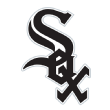
35-25 | AL seventh seed | 6.0% World Series odds
Odds by round
WC: 51.0% vs. Athletics
ALDS: 63.8% vs. Astros; 47.7% vs. Twins
ALCS: 68.9% vs. Blue Jays; 54.4% vs. Yankees; 54.3% vs. Indians; 47.9% vs. Rays
WS: 76.3% vs. Marlins; 68.1% vs. Brewers; 67.5% vs. Reds; 61.9% vs. Cardinals; 60.6% vs. Cubs; 55.0% vs. Braves; 43.0% vs. Padres; 29.9% vs. Dodgers
How they could go far: The White Sox hitters have to be disciplined against elite pitching and that has not been a strength of a moderately diverse Chicago attack. White Sox batsmen rank in the bottom five in the majors in both chase rate and contact rate, and they don’t make up for those shortcomings by taking pitches. But when they do make contact, they hit it hard, from gap to gap and over the fence. It’s a dossier that seems vulnerable to pinpoint pitching — the kind you typically see in the playoffs. Still, Chicago is a top-10 scoring offense and any hopes the White Sox have of going deep rest on the hitters creating leads that a potentially solid back of the bullpen can protect. — Doolittle
How they could go home before you’re done reading this: The White Sox will be in trouble if their hitters don’t pass the baton, so to speak, and instead try to do too much against top-flight hurlers. That would result in the club playing uphill, especially if Chicago’s tepid rotation can’t string together zeros. Because the White Sox are collectively so aggressive at the dish, not only can they be exploited by good pitchers but those same pitchers can find themselves cruising into the middle innings with low pitch counts. If Chicago finds itself going against an ace starter or two who hands the ball directly to a couple of good high-leverage relievers, it could be a brief return to the postseason for the still-green White Sox. — Doolittle
Most likely October hero: A pitcher is usually the best bet here and Lucas Giolito is lights out when he’s on, but Jose Abreu has been locked in all season and has actually performed better against good teams. Plus, after spending his first six seasons with the White Sox on losing teams, you would love to see him excel in the postseason. He’ll chase out of the zone but has destroyed fastballs better than ever this season. — Schoenfield
Matchup to watch in Round 1: White Sox hitters versus the strike zone. Not only do they have one of the highest strikeout rates in the majors (24th), but they were next to last in chase rate. Luis Robert’s 40% chase rate led to a mammoth slump in September and Tim Anderson has managed to excel despite a similar rate. Eloy Jimenez is also above 35%. Will the better pitchers of October exploit their aggressive approach? — Schoenfield
Their only-in-2020 stat: The White Sox are second in the American League in runs per game and OPS+, and what’s especially remarkable about that is how little offense they’ve gotten from traditionally offensive positions: Their right fielders were the AL’s worst, and their designated hitters and third basemen were the AL’s second worst. Indeed, the White Sox got about 10% more production at “defense-first” positions — catcher, the middle infield and center field — than offensive positions. (First base, with Abreu, is the exception.) Since 2000, only five American League teams have gotten a more disproportionate share of their offense from defensive positions. — Miller
One bold prediction: Rookie Nick Madrigal, he of the comically low strikeout rate, will fight off pitches in a long at-bat and deliver a run-scoring single that ties a game or puts the White Sox ahead. — Passan
8. Toronto Blue Jays

32-28 | AL eighth seed | 1.1% World Series odds
Odds by round
WC: 35.2% vs. Rays
ALDS:: 35.8% vs. Yankees; 35.7% vs. Indians
ALCS: 47.6% vs. Astros; 35.1% vs. A’s; 31.1% vs. White Sox; 30.3% vs. Twins
WS: 60.1% vs. Marlins; 49.7% vs. Reds; 43.6% vs. Cardinals; 47.9% vs. Brewers; 40.0% vs. Cubs; 34.5% vs. Braves; 26.2% vs. Padres; 16.3% vs. Dodgers
How they could go far: Charlie Montoyo is tasked with putting together a playoff bullpen on the fly on an evolving Toronto roster. The Blue Jays had two rookie pitchers who raised eyebrows during the season, reliever Jordan Romano and starter Nate Pearson. Both were injured and on the sidelines for the Blue Jays’ stretch run. Pearson was activated late in the campaign and should work in a bullpen role. Romano is aimed at getting back in action for the playoffs, though it’s not a sure bet. When you look at a rotation that needs the best from its top two of Hyun-Jin Ryu and Taijuan Walker just to keep Toronto in games, it seems like a surprise Blue Jays run could be fueled by Romano and Pearson coming together in a dynamic ad-hoc October bullpen. — Doolittle
How they could go home before you’re done reading this: The Toronto offense is fueled by talented young bats, but the offense has been an uneven, feast-or-famine outfit for most of the campaign. After a ragged start, Vladimir Guerrero Jr. has been mashing of late. Unfortunately, after carrying the Toronto offense in the opening weeks, Bo Bichette and Teoscar Hernandez have been so-so after returning from injury. The Blue Jays’ defense rates from below average to terrible, depending on the metrics you view. The pitching staff remains an area of flux even as the high-stakes games begin. For Toronto to surprise, the young hitters all must be clicking. — Doolittle
Most likely October hero: Hernandez has a lot of swing-and-miss in his game, but when he connects few batters hit the ball harder as he ranked in the 98th percentile in hard-hit rate and the 99th percentile in expected slugging percentage. He’s the kind of hitter who might be exposed by the better postseason pitching, but he has been terrific all season and could go on a long-ball hot streak. — Schoenfield
Matchup to watch in Round 1: The Rays had the third-highest average fastball velocity in the majors, with Game 1 starter Blake Snell averaging 95.0 mph and Game 2 starter Tyler Glasnow averaging 96.9. The Blue Jays were not a great fastball-hitting team, however. They ranked 12th in the majors in overall wOBA, but just 25th against fastballs. Hernandez (.388, 1.291 OPS) and Bichette (.333, .967 OPS) were their best hitters against fastballs. — Schoenfield
Their only-in-2020 stat: As a backup catcher on the Blue Jays’ taxi squad this year, Caleb Joseph has traveled with the club, and his role has mostly been leading the postgame win celebrations — “senior clubhouse vibe coordinator,” he called his role. He has played only three games, starting two of them, batting nine times. Those nine plate appearances were notable because they were the only plate appearances by any Toronto hitter over 31 years old. Even the rebuilding teams have used far more oldsters: The Pirates have had 15 games started by older hitters, the Orioles 21, and every other team far more than that. Joseph homered in one of his two starts. — Miller
One bold prediction: Rookie right-hander Pearson, pitching out of the bullpen, is going to throw a fastball harder than 102 mph — and it will be the single fastest pitch delivered in 2020, topping the 102.2 mph fastball thrown by Kansas City rookie Josh Staumont. — Passan
[ad_2]







